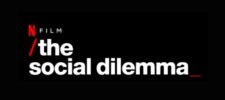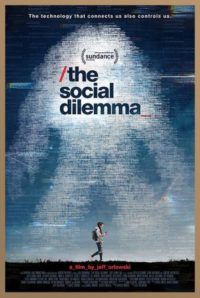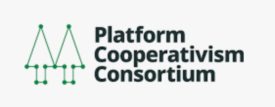The Social Dilemma, now on Netflix, is a polemic, not a documentary. I mean, the Oxford English Dictionary says a documentary “provides a factual record or report,” and this film does not do that. There’s nothing wrong with a polemic, or a wakeup call. It’s perfectly reasonable to create a film with the intention to wake people up from using tech and media unthinkingly. It is wrong to represent the critic’s truth as everybody’s reality, especially when so many people already fear it is. That’s bias confirmation.
 Interviewing remorseful technologists and the most well-known social media critics is a commentary. Adding a cheesy sci-fi-style portrayal of an algorithm as three sociopaths at an instrument panel toying with helpless teenagers, along with fictional scenes of a family’s smartphone struggles with which many viewers will identify is pure manipulation. Which is interesting. It’s like using unethical methods to take the moral high ground.
Interviewing remorseful technologists and the most well-known social media critics is a commentary. Adding a cheesy sci-fi-style portrayal of an algorithm as three sociopaths at an instrument panel toying with helpless teenagers, along with fictional scenes of a family’s smartphone struggles with which many viewers will identify is pure manipulation. Which is interesting. It’s like using unethical methods to take the moral high ground.
Ok, so now I’ll tell you how I really feel. ;) Seriously, there are some great dinner table and classroom talking points in the film if everybody goes in fully informed that it mashes up fact and fiction, leaves you with a gnawing sense of helplessness and paints a very dark picture that represents all social media users as addicts, crash test dummies (not the Canadian rock band) or sitting ducks. [Teens who feel insulted by the way they’re portrayed in this film deserve to be heard.]
A few of the talking points
With that kind of preparation up front – and some of the academic research linked to below and elsewhere in this blog – this is great fuel for growing both mindfulness and media literacy. So let’s look at a few arguments in the film….
Internet pioneer Jaron Lanier says, “We’ve created a world in which online connections become primary – especially younger generations.” Ask teenagers you know if they prefer to connect with their friends online, rather than in person, if that’s what Lanier means. They might say, “sometimes” or “in some situations,” but I suspect many would be confused, because online is just one way to connect with their friends. What’s “primary,” to use Lanier’s word, is just connecting/socializing with them not the how of it. But we need to ask them.
There’s no arguing with what software engineers say about their past A/B testing, feature tweaks and contagion experiments. But there are plenty of ongoing arguments in academia about digital media’s actual effects. The film does not distinguish between corporate product research and academic research on users’ experiences, and it assumes companies’ intentions for their products are users’ outcomes. We get nothing about the latter except a dramatization of that assumption.
 One of the software engineers says, “It’s ok for companies to be making money. What’s not ok is when there are no rules, no regulation … no competition, and the companies are acting as de facto governments.” We’ve heard these legitimate arguments before – on that last point, see commentaries in Medium.com, the Financial Times and NPR – but they cry out for thoughtful discussion with multiple perspectives in a real documentary. What about considering potential solutions?
One of the software engineers says, “It’s ok for companies to be making money. What’s not ok is when there are no rules, no regulation … no competition, and the companies are acting as de facto governments.” We’ve heard these legitimate arguments before – on that last point, see commentaries in Medium.com, the Financial Times and NPR – but they cry out for thoughtful discussion with multiple perspectives in a real documentary. What about considering potential solutions?
Tech ethicist Tristan Harris acknowledges, “A lot of what we’re saying sounds like it’s just this one-sided doom and gloom…. No. It’s confusing because it’s simultaneous utopia and dystopia.” That does not make the film balanced or solve the widely felt problem of what to do with this 21st-century Dr. Frankenstein’s monster.
Mining our data
Jaron Lanier says, “These guys didn’t set out to be evil. It’s the business model that’s the problem.” One problem is that the ad-supported “free” content business model predates social media; it’s the model that the giant consumer products companies taught Facebook, according to Procter & Gamble’s Marc Pritchard (see what he said about that under “Related links” in this piece).
What’s actually new about the business model – the new Frankenstein monster – is ably described by former Facebook and Google engineer Justin Rosenstein. He says, “We’re the earth that’s mined for profit – our attention, our data are mined for profit…. The attention extraction model is not how we want to treat human beings.”
That right there is the core issue we all need to discuss, without dramatization and with many more perspectives than those in The Social Dilemma. That and what to do about it.
If regulation is the solution, then regulators need to be informed and nuanced enough to look at the “extraction model” – across the whole new media ecosystem (including data brokers and ad networks), not just social media. Could regulation be informed and apolitical enough to do that? It’s a huge question, one that some very smart people have been looking at (for example, see this about a new kind of regulation a law professor proposed). I believe it can only be part of the solution.
A community-focused business model
Another question is how do public companies that depend on our data to maximize profit for their shareholders give us control of our data? None of the people interviewed in The Social Dilemma has an answer to that. I think the beginnings of an answer can be found in a new-old model and movement that a professor at The New School in New York, Trebor Scholz, coined “platform cooperativism” – post-“sharing economy” (beyond Uber, TaskRabbit and AirBnB), which also didn’t give us control of our data. Cooperatives are owned and run by their members. Under that model, members’ data in digital-age co-ops is owned and controlled by the members.
While the model dates back to the 19th century and is used all over the world now (making up 4.3% of the global GDP), people started developing co-ops using the Internet and digital tools to varying degrees just in the past 10 years. As chronicled by Scholz and Nathan Schneider, a professor at University of Colorado, Boulder, in the 2015 book Ours to Hack and to Own and convened at annual conferences in Berlin, Hong Kong and New York (so far), the movement has proponents and practitioners all over the world.
But this is not just AirBnB to FairBnb. In addition to member ownership, governance and control of data, digital cooperativism is also working to grow a more cooperative-friendly business climate and legal structure and to develop a new financing and investment model. Schneider calls the latter “Exit to Community” (E2C), where startups exit to ownership by their communities rather than to acquisition or an IPO, as under the venture-capital model. Cooperators even have stakes in the very current Big Tech antitrust discussion, recently arguing in the Penn State Law Review that cooperative ownership “can mitigate the effects of monopoly and oligopoly, as well as advance the interests of consumers, workers, small business owners, and citizens.”
So back to the film. If you haven’t already, go ahead and watch it. If you’ve gotten this far here, maybe you’ll see it for the dark, dramatic rabbit hole it is. There’s something ironic about creating a rabbit hole that warns against going down rabbit holes. If it makes you feel guilty or hopeless, you don’t deserve that. If it makes you think and look for solutions – such as mindfulness about tech use, critical thinking about media messages, kindness toward self and others, smart regulation and new business models you might want to support – that would be the best possible takeaway. I just wish I felt that was the film’s goal.
SIDEBAR: A bit of background on platform cooperativism
 Cooperativism has had its fits and starts. As author and professor Nathan Schneider put it, “Co-ops tend to take hold when the order of things is in flux, when people have to figure out how to do what no one will do for them.” And this just may be one of the most fraught, flux-y, discontinuous, ripe moments yet – perhaps closer to “post-growth” than ever (see The New Yorker‘s “Can we have prosperity without growth?” on that). But look at how established cooperativism actually is today, with its principles laid out in Rochdale, England, in 1844, most recently updated by the Brussels-based International Co-operative Alliance (ICA) in 1995 and a Platform Cooperative Consortium established in New York in 2016. According to the Consortium, “As much as 10% of the world’s total employment happens through co-ops. According to the United Nations, the world’s 2.6 million co-ops count over 1 billion members among them, plus $20 trillion in assets, with revenue that adds up to 4.3% of the global GDP. In the United States, a national survey showed that nearly 80% of consumers would choose co-ops over the other options if they had a choice.” See also Ours to Hack and to Own, with 25 examples of platform co-ops (OR Books, 2016), Everything for Everyone for history and context (Nation Books, 2018) and Exit to Community, a primer and story “that connects the founders, workers, users, investors, activists and friends who have been trying to feel their way toward a better kind of startup” (Media Enterprise Design Lab and Zebras Unite, 2020).
Cooperativism has had its fits and starts. As author and professor Nathan Schneider put it, “Co-ops tend to take hold when the order of things is in flux, when people have to figure out how to do what no one will do for them.” And this just may be one of the most fraught, flux-y, discontinuous, ripe moments yet – perhaps closer to “post-growth” than ever (see The New Yorker‘s “Can we have prosperity without growth?” on that). But look at how established cooperativism actually is today, with its principles laid out in Rochdale, England, in 1844, most recently updated by the Brussels-based International Co-operative Alliance (ICA) in 1995 and a Platform Cooperative Consortium established in New York in 2016. According to the Consortium, “As much as 10% of the world’s total employment happens through co-ops. According to the United Nations, the world’s 2.6 million co-ops count over 1 billion members among them, plus $20 trillion in assets, with revenue that adds up to 4.3% of the global GDP. In the United States, a national survey showed that nearly 80% of consumers would choose co-ops over the other options if they had a choice.” See also Ours to Hack and to Own, with 25 examples of platform co-ops (OR Books, 2016), Everything for Everyone for history and context (Nation Books, 2018) and Exit to Community, a primer and story “that connects the founders, workers, users, investors, activists and friends who have been trying to feel their way toward a better kind of startup” (Media Enterprise Design Lab and Zebras Unite, 2020).
Related links
- Other solutions that have been put forth: It’s really a solution ecosystem that needs to be built out, consciously and collaboratively, pre- and post-product launch, right? Besides the business model, financing/investment, smart regulation and of course user care/content moderation, two others greatly needed are risk assessment built in before social product/service launches, as in other industries (see this just-published investigative piece in OneZero) and independent helplines, meaning getting the social media industry to build out this global “middle layer” of independent care between the cloud and traditional, vertical-interest hotlines on the ground such as the Trevor Project helpline or the Suicide Prevention Lifeline. That middle layer includes, for example, Europe’s Internet helplines, Australia’s eSafety Commissioner’s Office and New Zealand’s Netsafe (see my post on this for more moving parts).
- 2 interesting highlights in Medium.com senior writer Will Oremus’s review of The Social Dilemma:
- Ignores the positives for youth: Oremus cites activist Evan Greer’s contention that “the film almost entirely ignores social media’s power to connect marginalized young people, or to build social movements such as Black Lives Matter that challenge the status quo. This omission is important, not because it leaves the documentary ‘one-sided,’ as some have complained, but because understanding social media’s upsides is critical to the project of addressing its failures.” No question.
- Ignores conditions underlying media: Citing podcast host Paris Marx in making the case “that The Social Dilemma misidentifies social media as the primary source of contemporary strife by overlooking ‘the underlying economic conditions: four decades of neoliberalism, rising inequality and corruption’” (for more on exactly that, see Peter Pomerantsev’s This Is Not Propaganda) and journalist and author Cory Doctorow contending that what Shoshana Zuboff (who appears in the film) “calls ‘surveillance capitalism’ is better understood as simply ‘capitalism’.”
- Other reviews of the film in the New York Times, Slate and the Associated Press and, at The Verge, from Adi Robertson and Casey Newton
- Earlier piece on remorseful technologists: “The Prodigal Techbro” in The Conversation
- An interview with Nathan Schneider on platform cooperativism in Logic magazine
- “Social media’s turning point. 5 steps needed now, no turning back,” my June 8 post in Medium.com
- “Can’t Delete: Why We Stay on Social Media,” by Bree McEwan, PhD, in Psychology Today
- Antidotes and resources for any parents triggered by the film’s dramatization:
- About a book full of all kinds of parents’ experiences: Parenting for a Digital Future, by Prof. Sonia Livingstone in the UK and Alicia Blum-Ross in California
- “Social media rescues young people’s sanity” (June 2020) by Candice Odgers, PhD, in the Child & Family Blog, a project of the University of Cambridge (UK), the University of Princeton Future of Children project (USA) and the Jacobs Foundation (Switzerland)
- About avoiding the digital safety “control paradigm” researchers are warning about.
- On video: “We’re letting our fear and our skepticism about these devices hold us back from realizing their potential in our children’s lives,” said Sara DeWitt of PBS Kids in her TED Talk “3 Fears About Screen Time – and Why They’re Not True,” which has gotten nearly 1.7 million views.
- Research about “screens kids use” – Part 1 and Part 2 – and an antidote from psychologists for parents feeling the media siege
- I am a proud board member of the National Association for Media Literacy Education.

Anne, thanks for for the thorough perspective and the “homework” suggestions at the close of your piece. Often critics skip the comparison to “old” media, as if it were without its own challenges. You remind us as well to look inclusively at the entire ecosystem social media exists in.
If developed “adult” minds need to be reminded to use media literacy skills when consuming content ( thanks, we do!), imagine the challenges for developing young minds.
Thankyou. As ever, thoughtful and knowledgeable comment – jut what we need in the swirl of sensationalised headlines and panics. By we – I mean those of us engaged in delivering training and information to schools, services for children, and parents. Our annual survey results will be out soon, adding the voices of young people to the conversation.